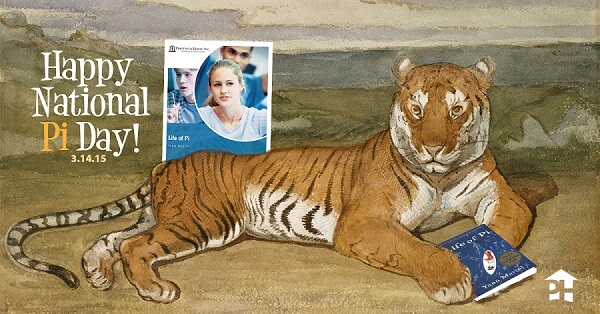
Pi for Pi Day … What a Wonderful Life!
by Douglas Grudzina
Prestwick House used to offer a sweatshirt as a raffle prize and free gift. It was an ordinary-enough gray shirt, but it was inscribed with the clever epigram, “I am an English teacher; you do the math.”
Somehow, though, even though we’re "non-math-doing" English teachers, we’re going whole hog this year to celebrate National Pi Day. Maybe, just as “everyone’s Irish” on St. Patrick’s Day, everyone’s a mathematician on Pi Day.
Pi, as I’m sure you remember from your high school geometry, is the Greek name for a magical number, the ratio between a circle’s diameter and circumference. It’s the key ingredient in such delectable formulas as Circumference equals pi times diameter (c = πd) and Area equals pi times the radius squared (a = πr2).
After the decimal point, the number goes on forever, but we generally consider 3.1415 to be sufficient. For most common purposes, we abbreviate it even further—to 3.14.
National Pi Day came about because of the way we write dates in the United States: month/day. March 14 is written as 3/14, and 3.14 is the magic number pi, so March 14 is “Pi Day.” It’s sort of a visual-numeric pun. This year is even more special because the full date (3/14/15) will correspond to pi calculated out to the fourth decimal place—3.1415!
What’s even more special is that, at precisely 9:26:53 a.m., the date and time will represent the pi sequence to the ninth decimal place: 3.141592653!
Those mathematicians are such madcap folks. It’s hard to keep up with them.
MIT traditionally mails or posts online their acceptance letters for the next academic year on Pi Day. Since March 14 is also the anniversary of Albert Einstein’s birth, Princeton, New Jersey, hosts pie-eating contests and Albert Einstein Look-Alike contests.
And here at Prestwick House, we’re pulling out all the stops in our celebration of National Pi Day. Of course, we’ll be letting fly with all of the pi puns anyone ever thought of (apple π, π à la mode, and so on). We’ll keep each other in stitches with endless pi jokes:
Q: What do you get when you divide the circumference of a jack-o’-lantern by its diameter?
A: Pumpkin π!
Q: Who was the fattest knight at King Arthur’s Round Table?
A. Sir Cumference.
Q: Why was he so fat?
A: He ate too much pi!
But best of all, is the wonderful Life of Pi special offer we’re making:
Save $5 off our Life of Pi Literature Teaching Unit, 30 Books plus Teaching Unit Package, or the Downloadable Teaching Unit.
With an offer like that, who could turn down a slice of pi?
Now here are some math-related fun facts about Pi Patel and Life of Pi that you probably already knew, but (as I said) they’re fun:
- Pi’s name has nothing to do with circles or geometry. His actual name is Piscine Molitor Patel. He was named after a public swimming pool in Paris, the Piscines Auteuil-Molitor.
- Piscine means “of or concerning fish.” Think of the Zodiac sign Pisces.
- Piscine also means “swimming pool” in French.
- According to photographs on the Internet, the Piscines Auteuil-Molitor is rectangular, not round.
- Piscine Patel adopts the nickname Pi because his full name sounds like something you’re not supposed to do in a public swimming pool.
- The plot of the novel and Pi’s narration reveal young Pi Patel to be a round character.
- In mathematics, 3.1415 is often expressed as 22/7, and Pi Patel spends 227 days at sea after the ship on which he and his family are traveling sinks.
- The ship was on (and later in) the ocean, which is a feature of the earth.
- The earth is round, with a circumference (at the equator) of 24,901.55 miles and a diameter (at the equator) of 7,926.28 miles.
- The ratio between the earth’s circumference and diameter is roughly 3.1416. So, while 3/14/15 might be National Pi Day, 3/14/16 will most likely be Earth Pi Day.
Just as the circle is never ending, I have no idea how to finish this post, other than to say that National Pi Day comes a-round but once a year, and this year, especially, you’ll want to jump on our Life of Pi pi-day promotion. Just remember the immortal words of a mathematician-turned-pastry-chef who was much wiser than I, “Caution! Contents might be hot!”